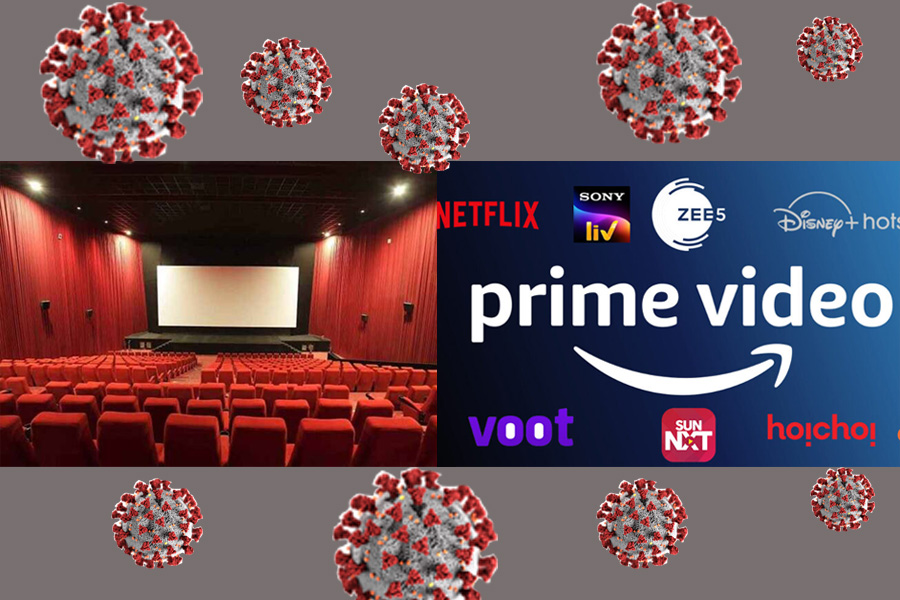
11 Aug Media & Entertainment Industry: During and after Covid 19
In 2019, the Indian Media and Entertainment (M&E) industry, was a sunrise sector for the country’s economy.
M&E sector, which consists of multiple segments such as Movies/Cinema, Television, Music, Publishing Radio, Internet, Advertising, Print, Animation and Gaming etc. was making high growth strides in 2019. A report by The Federation of Indian Chambers of Commerce and Industry (FICCI)- EY (Ernst and Young) found that the Indian M&E industry sector reached INR1.82 trillion (US$25.7 billion) in 2019, a growth of approximately 9% over 2018. Considering the growth trajectory of 2019, the Report predicted that the M&E sector in India may cross INR2.4 trillion (US$34 billion) by 2022, at a Compound Annual Growth Rate (CAGR) of 10%.
But the onslaught of the COVID – 19 pandemic has shattered this entire positive outlook for M&E. The pandemic has affected the social lives of people across regions and economic sections. This new unprecedented scenario has affected the M&E sector badly and this industry is now staring at INR 25,000 crore loss, according to CRISIL, an Indian analytical company providing ratings, research, and risk and policy advisory services.
The lockdown has had varied effects on the multiple sectors in the media and entertainment industry. Most cinemas around the world are shut, releases are held up, and the production of films is indefinitely delayed.
The state governments of various states announced a complete lockdown of public places like theatres in their states by March 15, 2020. This was followed by the social distancing advisory issued by the Ministry of Health and Family Welfare on March 16, 2020. These measures led to a shutdown of theatres countrywide. The Producers Guild of India (“PGI”), Federation of Western Indian Cine Employees (“FWICE”), Indian Film & Television Directors’ Association, Indian Motion Pictures Producers’ Association, Western India Film Producers’ Association, Indian Film and TV Producers Council (“IFTPC”), Association of Film & Video Editors decided to put all shootings of films, television serials, web series, and advertising films, on hold from March 19, 2020.
The stoppage of shooting in Bollywood has exposed harrowing stories of daily wage earners who depend on the industry for their daily bread and butter. Organizations such as CINTAA, TWICE, and the Production Guild of India, actors and other production houses have stepped up their efforts to support these workers. Due to imposition of the nationwide lockdown, all shooting schedules continue to be suspended till recently. Though the blanket ban was withdrawn, the production works are happening at snail’s pace. And the maintenance of safety norms of these workers still remains in question. The release of several big-budget films was also deferred indefinitely, including big-ticket movies including Akshay Kumar- starrer “Sooryavanshi”, and multi-lingual historical epic “Marakkar: Lion of the Arabian Sea” etc. In a major setback, Angrezi Medium, starring Irrfan Khan, Kareena Kapoor and Radhika Madan, was forced to withdraw from theatres just one day after its release due to the abrupt shutdown in metros. Other commercial movies which postponed its release to 2021 was Maidaan, starring Ajay Devgn and Keerthy Suresh and Thalaivi, starring Kangana Raut.
Dark days for Events
If the movie industry has it bad, then imagine an industry that is completely based on gatherings. Events include award shows, meetings, conferences, exhibitions, competitions, music festivals, etc was badly affected. Cancellation of all live events led to the postponement of 13th edition of the Indian Premier League (“IPL”). The event management sector is looking at huge losses (INR 3,000 crore, at least as of the end of March). The livelihoods of a major chunk of people related to the event industry- 10 million people directly, and 50 million indirectly- will be affected.
The impact of the pandemic and the global recession on various industries such as e-commerce, manufacturing, financial services, fashion and retail, automobiles, hospitality and travel among others, has led to reduction in advertising spends from these sectors.
The Indian Broadcasting Foundation claimed that advertisement bookings have gone down by almost 50%, owing to various factors including cancellation of big events like the IPL, repeat content on television, and slowdown in other industries. Similarly, the newspaper industry is also reportedly among the worst affected in India, with decreasing revenues from both advertising and circulation, given the nationwide lockdown; and is estimated to have affected lakhs of workers engaged in the news industry.
OTT Platforms- a glimmer of hope
While the segments that rely on social gatherings like films, theatres, live events and theme parks have been affected adversely, the public adhering to the Advisory on Social Distancing has led to an increase in consumption of content on other mediums – such as television, digital streaming platforms, and gaming platforms. In fact, reportedly, viewership across several digital entertainment platforms in India has increased by almost 20%. Despite the rise in Television viewership, monetisation and revenues are hugely impacted, considering reduction in ad-spends by other industries owing to the global recession.
But during these dark times, big hope was OTT(over-the-top) media services. Apart from streaming giants Amazon Prime Video, Netflix and Disney+ Hotstar, the other popular OTT platforms were Zee5Disney+ Hotstar, Shemaroo, Eros Now, and SunNxt etc. While Hotstar, Amazon Prime and Netflix in India have seen an 82.63% increase in time spent, YouTube has clocked a 20.5 percent surge in subscribers. YouTube, which is growing at a rate of 13 percent after the fourth quarter of 2019, registered over 300 billion views in the first quarter of 2020.
Amazon Prime unleashed a big storm in India through online streaming. Amazon directly released a clutch of big-ticket movies during Covid 19 pandemic in India. These movies include Amitabh Bachchan-starrer Gulabo Sitabo and Ponmagal Vandhal(Tamil) featuring Jyothika etc. The other movies directly released on Amazon Prime were Law and French Biryani, both Kannada movies, Shakuntala Devi (Hindi), Sufiyum Sujatayum (Malayalam) and a bi-lingual movie Penguin (Tamil, Telugu).
Netflix will be streaming the much-awaited biopic Gunjan Saxena starring Janhvi Kapoor in the lead role on August 12. Disney+ Hotstar has announced a series of highly-awaited films that will be releasing on its platform. Leading the charge was Dil Bechara, starring the late Sushant Singh Rajput, which released online on July 24, 2020. Before we’re done reeling over this terminal romance, we were bitten by the comedy bug with Lootcase, which released on July 31, 2020. Other movies with unconfirmed release dates to be released on Hotstar include the Akshay Kumar starrer Laxmmi Bomb, Ajay Devgn starrer Bhuj: The Pride of India, Mahesh Bhatt directorial Sadak 2, and Abhishek Bachchan starrer The Big Bull. Vidyut Jammwal starrer Khuda Hafiz comes to Hotstar on August 14, 2020.
Sun Nxt has bagged the streaming rights of nine Tamil films – Ayalaan (starring Sivakarthikeyan), Kombu Vacha Singamda (starring Sasikumar), Naa Naa (starring Sasikumar and Sarathkumar), Oomai Vizhigal (starring Prabhu Deva), Pannikutty (starring Yogi Babu and Karunakaran), Party (a Venkat Prabhu directorial), Raangi (starring Trisha), Raja Vamsam (starring Sasikumar), and Trip (starring Sunainaa and Yoji Babu). Zee5 has also lined up the releases of movies across languages. Mee Raqsam, starring Naseeruddin Shah releases on August 21, 2020.
The direct premiere on OTT platforms is an indication of what the future has in store for the thriving entertainment industry in India. Apart from the big platforms such as Amazon, Netflix, Hotstar, Sun Nxt, Disney+Hotstar etc., it is assumed that a number of small and medium new players will emerge in the OTT sector in future. But in case of OTT, content is king. So, those who provide high quality content can only survive.
Online Film Festivals to keep the show alive
The coronavirus pandemic has badly affected the circuit of film festivals too. Major events on the calendar have either been pushed down the calendar or cancelled. The high-profile Cannes Film Festival has been delayed. While some other major events, such as the Venice Film Festival and the Toronto International Film Festival, are still on track, questions remain about travel arrangements for international delegates and safety protocols during screenings.
Some festivals, such as New York’s Tribeca, have moved part of their programmes online. Other festivals, such as Locarno in Switzerland, have jettisoned the main event and set up initiatives to support independent filmmakers who are struggling to finish their works or secure funding for future projects.
If education and doctor’s consultations can go online, why not a film festival? Though a film festival cannot be replaced easily by an online festival, but the attempt has been considered as a step towards reinventing the Film festivals. Film festivals are about celebrating cinema, and all celebrations can happen only when the film personalities and fans together enjoy the moment. But, Covid-19 has robbed this ‘togetherness’ due to the social distancing. But anyway, Online festivals are a big relief. The 10-day global film festival co-curated by over 20 film festivals from across the world held from May 29 to June 7. This online festival, called ‘ Are One: A Global Film Festival’ was an unforgettable event that unites curators, artists and storytellers to entertain and provide relief to audiences and film fans worldwide. The world-renowned Film Festivals which were part of this online festival were Tribeca, Cannes, Venice, Berlin, London, Karlovy Vary, Locarno, Marrakech, San Sebastian, Toronto and Tokyo.
Changed content consumption patterns
The lockdowns and restriction on movement of people has not only led to an increased demand for content but has also changed content consumption patterns.
There has been increased usage of OTT platforms over the last few months. Multiple platforms are providing subscription-free usage of their services to induce habit formation (KPMG), in the hope that this will lead to greater subscribers as we return to normalcy. Many users, who may have never experienced OTT services before, are opening themselves up and exploring them. They are also getting used to, and fond of, the ‘pause and play’ options that are not available on dish television operators. Of course, as with television, platforms must make do with the content they already have. However, among other things, this trend has emphasized the permanence of digitization.
Going forward, it is likely that advertisers turn their focus even more to the Internet. The Bollywood movie, Angrezi Medium, which could not have a box office release, was released on Disney+ Hotstar. This is not a viable option for all movies, however, considering that they may not reach the right audiences, or platforms may not be able to support big-budgeted films.
In addition to the lockdowns adversely impacting a large number of daily wage earners, and freelance creative talents, decreasing revenues and uncertainly around recovery from the pandemic, unfortunately also triggered a number of layoffs and pay-cuts in the media industry. Going forward, the industry will need to re-think various operational and legal aspects of the business, such as timelines, production costs and schedules, legal commitments etc., in order to adjust to the ‘new normal’ being presented to the world. OTT platforms, where a large chunk of the content library comprises of acquired content, or is dependent on partnerships with third parties, may have to think of innovative ways of updating their existing content libraries, given that the production of new content may take much longer than anticipated earlier.
However, on the bright side, the demand for home consumption mediums including digital streaming services, which are hugely popular since even before the pandemic, is likely to increase even further. In the long run, this may in fact benefit subscription-based services which may be able to penetrate even further amongst viewers. However, availability of new content could prove to be a key factor in retaining and increasing the subscriber base for subscription-based platforms.
Production houses, keen on anticipated revenues, will have to put future projects on hold. A KPMG report points out that in order to stay afloat and avoid cash crunches, investments in large projects will most probably be avoided. In other words, the effect of the lockdown and virus are likely to carry on till FY21.
With theatre releases postponed, shooting on hold, and cinema halls closed, absolutely nothing is certain. Even when theatres open, social distancing norms and weakened livelihoods are likely to prevent people from thronging to watch movies. This pandemic has revealed that the migrant workers and daily wagers, the regular theatre-goers, have been the worst affected. With large-budgeted films competing for release dates, smaller productions may lose out.
Given the above, while the media and entertainment sector is currently grappling with various challenging issues, however, as people strive to return to normalcy, eventually the sector may be amongst the first few to recover, and continue to provide to everyone across all mediums and segments, the much-needed entertainment. Media companies including production houses will also need to find ways of increasing their use and reliance on technology.
During the lockdowns and after, the M&E industry has been going through a dark tunnel. After long days of Covid19, the recovery will be slow, but definitely it cannot be delayed ‘forever’ as M&E industry is the ‘lifeblood of the existence of common folk. The demand for at-home digital media is expected to grow significantly, as habit-formation and ease of access emerge as drivers. OTT platforms and digital media have already been attracting new consumers and will be expanding to new locations and demographics.
One can foresee the co-existence of both traditional and digital experiences-theatres and OTT platforms- in the long -run owing to their relevance to a particular format of content. Once COVID-19 restrictions are eased and previous models of outdoor entertainment resume functioning, consumers will turn to theatres and entertainment events. It is more practical to say that most people watch OTTs on weekdays and watch movies over the weekend. The audience is likely to visit the theatre to seek an overall movie experience with a high amount of VFX and 3D, spend time with family and friends.
New age audiences are increasingly looking for fresh, relatable, and engaging content and are willing to spend extra money to seek OTT contents for completely transformative experiences. This customer experience will continue to occupy the centre stage of the entertainment industry. But, OTT Platforms that offer high-profile content and intuitive algorithms can only survive in the market. Hence it is highly inappropriate to say that OTT platforms will be the all new M&E and will lead to the death of movie theatre viewing.


